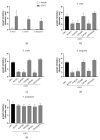Exploiting Conserved Quorum Sensing Signals in Streptococcus mutans and Streptococcus pneumoniae
- PMID: 36557639
- PMCID: PMC9785397
- DOI: 10.3390/microorganisms10122386
Exploiting Conserved Quorum Sensing Signals in Streptococcus mutans and Streptococcus pneumoniae
Abstract
Bacterial species of the Streptococcus genera are considered either commensal bacteria or potential pathogens, according to their metabolic evolution and production of quorum sensing (QS)-controlled virulence factors. S. mutans, in particular, has become one of the best-studied examples of bacteria that are able to get along or cheat commensal species, even of the same genera. S. mutans and S. pneumoniae share homolog QS pathways and a competence stimulating peptide (CSP) for regulating bacteriocin production. Intriguingly, the abundance of S. pneumoniae and S. mutans alternates in complex microbial communities, thus opening the role for the fratricide communication of homolog QS systems. Since the inhibition of the QS has been proposed in treating bacterial infections, in this study, we designed and synthesized analogs of S. pneumoniae CSP with precise residual modifications. We reported that S. pneumoniae CSP analogs reduced the expression of genes involved in the QS of S. mutans and biofilm formation without affecting bacterial growth. The CSP analogs inhibited bacteriocin production in S. mutans, as reported by co-cultures with commensal bacteria of the oral cavity. The peptide CSP1AA, bearing substitutions in the residues involved in QS receptor recognition and activation, reported the most significant quorum-quenching activities. Our findings provide new insights into specific chemical drivers in the CSP sequences controlling the interconnection between S. mutans and S. pneumoniae. We think that the results reported in this study open the way for new therapeutic interventions in controlling the virulence factors in complex microbial communities such as the oral microbiota.
Keywords: bacteriocin; competence-stimulating peptide; microbiota; peptide synthesis; quorum quenching.
Conflict of interest statement
The authors declare no conflict of interest.
Figures





Similar articles
-
Structure-Activity Relationships of the Competence Stimulating Peptide in Streptococcus mutans Reveal Motifs Critical for Membrane Protease SepM Recognition and ComD Receptor Activation.ACS Infect Dis. 2018 Sep 14;4(9):1385-1394. doi: 10.1021/acsinfecdis.8b00115. Epub 2018 Jul 23. ACS Infect Dis. 2018. PMID: 29990430 Free PMC article.
-
Identification of highly potent competence stimulating peptide-based quorum sensing activators in Streptococcus mutans through the utilization of N-methyl and reverse alanine scanning.Bioorg Med Chem Lett. 2019 Mar 15;29(6):811-814. doi: 10.1016/j.bmcl.2019.01.029. Epub 2019 Jan 25. Bioorg Med Chem Lett. 2019. PMID: 30711392 Free PMC article.
-
Inhibiting effects of fructanase on competence-stimulating peptide-dependent quorum sensing system in Streptococcus mutans.J Infect Chemother. 2017 Sep;23(9):634-641. doi: 10.1016/j.jiac.2017.06.006. Epub 2017 Jul 17. J Infect Chemother. 2017. PMID: 28729051
-
Quorum Sensing Regulation of Competence and Bacteriocins in Streptococcus pneumoniae and mutans.Genes (Basel). 2017 Jan 5;8(1):15. doi: 10.3390/genes8010015. Genes (Basel). 2017. PMID: 28067778 Free PMC article. Review.
-
Quorum sensing and biofilm formation by Streptococcus mutans.Adv Exp Med Biol. 2008;631:178-88. doi: 10.1007/978-0-387-78885-2_12. Adv Exp Med Biol. 2008. PMID: 18792689 Review.
Cited by
-
Anti-Bacterial and Anti-Biofilm Activities of Anandamide against the Cariogenic Streptococcus mutans.Int J Mol Sci. 2023 Mar 24;24(7):6177. doi: 10.3390/ijms24076177. Int J Mol Sci. 2023. PMID: 37047147 Free PMC article.
-
Probiotic Effect of Streptococcus dentisani on Oral Pathogens: An In Vitro Study.Pathogens. 2024 Apr 24;13(5):351. doi: 10.3390/pathogens13050351. Pathogens. 2024. PMID: 38787203 Free PMC article.
-
Oral streptococci: modulators of health and disease.Front Cell Infect Microbiol. 2024 Feb 22;14:1357631. doi: 10.3389/fcimb.2024.1357631. eCollection 2024. Front Cell Infect Microbiol. 2024. PMID: 38456080 Free PMC article. Review.
-
Interkingdom Detection of Bacterial Quorum-Sensing Molecules by Mammalian Taste Receptors.Microorganisms. 2023 May 16;11(5):1295. doi: 10.3390/microorganisms11051295. Microorganisms. 2023. PMID: 37317269 Free PMC article. Review.
References
Grants and funding
LinkOut - more resources
Full Text Sources
Molecular Biology Databases

